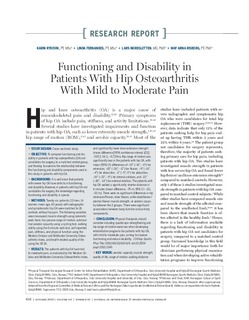| dc.description.abstract | STUDY DESIGN: Cross-sectional study. OBJECTIVE: To compare functioning and disability in patients with hip osteoarthritis (OA) not candidates for surgery, to a matched control group, and thereby to examine the relationship between the functioning and disability components used in this study in patients with hip OA. BACKGROUND: It is well known that patients with severe hip OA have deficits in functioning and disability. However, in patients with hip OA not candidates for surgery, the knowledge regarding functioning and disability is sparse. METHODS: Twenty-six patients (12 men, 14 women; mean age, 60 years) with radiographic and symptomatic hip OA were matched to 26 controls without hip pain. The following variables were measured: muscle strength using isokinetic peak force, hip passive range of motion, submaximal aerobic capacity using a cycling test, walking ability using the 6-minute walk test, self-reported pain, stiffness, and physical function using the Western Ontario and McMaster University Osteoarthritis Index, and health-related quality of life using the SF-36. RESULTS: The patients with hip OA had mild to moderate pain, as indicated by the Western Ontario and McMaster University Osteoarthritis Index, and significantly lower knee extension strength (mean difference [95% confidence interval {CI}]: –19.5 [–34.3, –4.7] Nm). Hip range of motion was significantly less in the patients with hip OA, with mean (95% CI) differences of –10° (–14°, –6°) for extension, –18° (–26°, –11°) for flexion, –9° (–14°, –4°) for abduction, –2° (–5°, 0°) for adduction, –16° (–23°, –9°) for internal rotation, and –21° (–28°, –14°) for external rotation. The patients with hip OA walked a significantly shorter distance in 6 minutes (mean difference, –75 m; 95% CI: –131, –20 m). There were no significant differences in hip extension/flexion, knee flexion, ankle dorsiflexion/plantar flexion muscle strength, or aerobic capacity between the 2 groups. There were significant associations between body function and activity components. CONCLUSION: Physical therapists should consider including quadriceps-strengthening and hip range-of-motion exercises when developing rehabilitation programs for patients with hip OA, with mild to moderate pain, aiming to improve functioning and reduce disability. | en_US |
